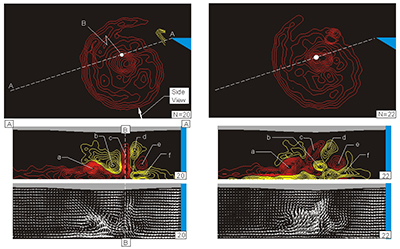You are here
Home ›Impulsively-Generated Vortex in Shallow Water
Impulsively-generated vortex in shallow water. A piston-channel arrangement generates a planar vortex system. A plan view of one of these vortices is shown in the top row of images at two instants of time, represented by frame N of the cinema sequence. This plan view was acquired using a horizontal laser sheet at an elevation of half the water depth. In this view, the distribution of vorticity shows the peculiar form of a highly concentrated small-scale region near the center of the vortex. In fact, this distorted form of the vortex is due to three-dimensional effects, which are revealed in the bottom row of images; They show vorticity contours and patterns of velocity vectors. These side views of the vortex structure were obtained by orienting a laser sheet vertically, such that it is coincident with line A-A. The direction of view associated with these side views is indicated by the white arrow in the top left image. Point B represents the projection from the center of the vortex on the vertical laser sheet A-A. In the side views, it is indicated by the vertical line B-B. The vorticity pattern of image N = 20, shows ordered concentrations a through f. Consideration of the entire set of images from the cinema sequence shows that the predominant vorticity concentration a actually is the first to be formed. It is located along the leading-edge of the primary, large-scale vortex indicated in the plan view. Subsequently, the remaining vorticity concentrations become evident. The velocity field of image N = 20 shows that the flow near the bottom surface is towards the center of the vortex. At a later instant, corresponding to N = 22, the concentrations of vorticity a through f are still identifiable, though their arrangement has been altered somewhat. It is hypothesized that the following concentrations can be paired, namely a-f, b-e and c-d. If this is indeed the case, then these paired cross-sectional cuts of the vortex system may suggest existence of a series of ring-like vortices that are stacked vertically.
For the plan view, the minimum and incremental values of vorticity are ωmin = ± 4 sec-1 and Δω = 2 sec-1 respectively; water depth is h*w = hw/W = 0.5, in which W is the jet nozzle width. Laser sheet for the plan view is at hL = hL/W = 0.25 above the bottom surface. For the side view, the minimum ωmin and incremental Δω values of vorticity are both = 3 sec-1.
An impulsively-started jet in shallow water gives rise to vortices having a characteristic diameter larger than the water depth. A technique of high-image-density particle image velocimetry allows characterization of the space-time development of the instantaneous flow patterns along planes representing the quasi-two-dimensional and three-dimensional vortex structure. The quasi-two-dimensional patterns exhibit different categories of vortex development and interaction, depending upon the depth of the shallow water layer.
These quasi-two-dimensional patterns are, in turn, related to specific forms of three-dimensional flow structure, which is highly-ordered. A prevalent feature is a vortex orthogonal to, and just ahead of, the primary, quasi-two-dimensional vortex. Its streamline topology, on a plane parallel to the axis of the quasi-two-dimensional vortex, exhibits a separation bubble with a well-defined separatix at the bottom (bed) surface. Moreover, its value of vorticity can exceed that of the quasi-two-dimensional pattern by a factor of two. This feature is consistent for all values of water depth. When the depth becomes sufficiently large, however, the three-dimensional vortex pattern involves an array of vorticity concentrations, which extend across the entire depth of the water.
On a plane very close to the bottom surface (bed), global, instantaneous distributions of velocity and vorticity exhibit large gradients; they are associated with small-scale vorticity concentrations. The corresponding streamline topology of the averaged flow close to the bed, however, exhibits a stable focus and is a direct indicator of the topology well above the bed.

